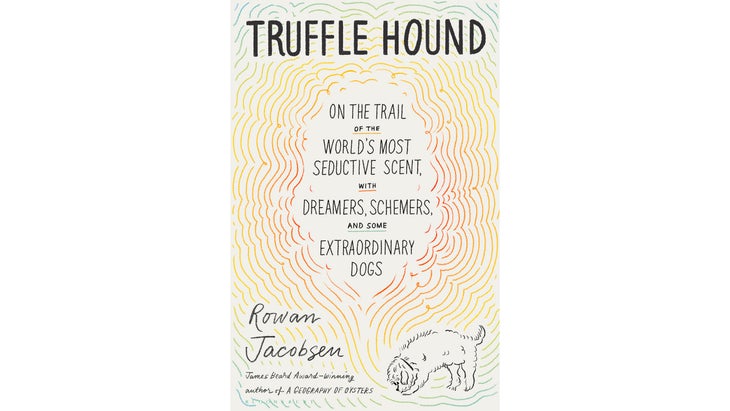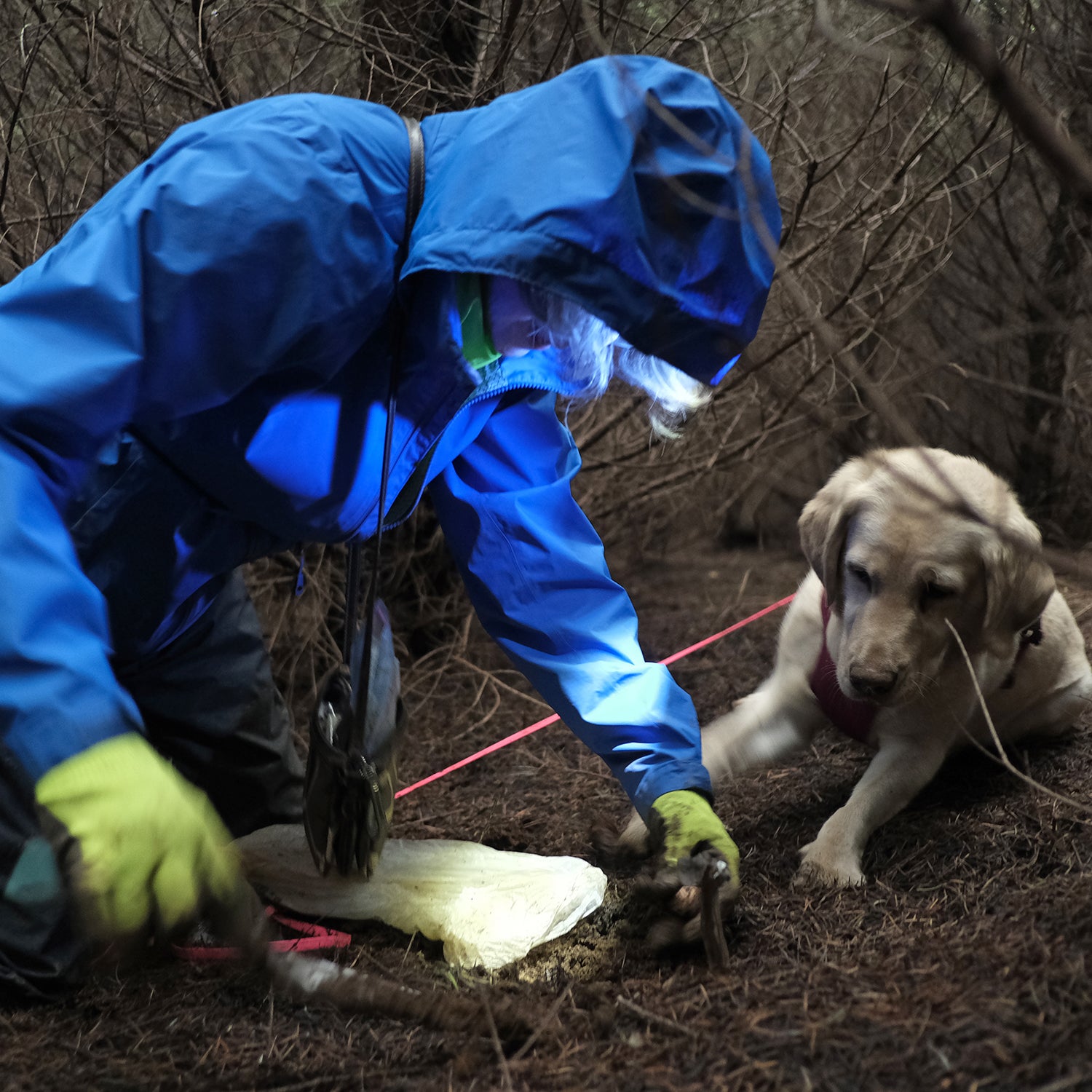Mycologist Charles Lefevre was always taught that Oregon truffles were no good. As a PhD student in mycology at Oregon State University (OSU) in the late 1990s, he put himself through school by foraging wild mushrooms and selling them to local restaurants, but he never messed with truffles, which were considered more of a novelty than a coveted ingredient. The few he encountered on menus were either bland or rotten.
At that time, the native truffles had several factors working against them. First, there were no truffle dogs in the Pacific Northwest. Harvesters used rakes, sieving the soil around Douglas fir trees and pulling up every truffle in the stand regardless of size or ripeness.
Second, Oregon truffles don’t start to ripen until mid-January, but what little demand there was for native truffles tended to be around the holidays, the traditional time to enjoy European truffles. The result was that the truffles that came to market had all the allure of unripe peaches.
Third, Oregon truffles have a very short shelf life, so the ones that weren’t underwhelming people with their woodenness were often terrifying them with their unholy excrescences.
The fourth factor was a consequence of the other three. The unloved truffles sold for about $25 per pound. At that rate, there was no incentive for better handling, or more attentive harvesting, or even for learning about the truffles. Consumers and chefs just steered clear, believing the only good truffles came from Europe.
Charles, however, was fascinated by all truffles. He knew the French and Spanish had been successfully cultivating black winters for decades, but that pioneers had struggled to do so in North America. While still in grad school, he invented new ways to inoculate tree seedlings with black winter spores, and launched New World Truffieres in 2000, seeding America’s new wave of truffle love.
But native truffles? Charles didn’t take them seriously until he began foraging for his own, also while in grad school. “Every year I wanted to find something bigger and better than what I’d found before,” he says as we chased after his two dogs, Lagotto Romagnolos named Dante and Mocha, in a forest in Oregon’s Willamette Valley. “You know, I’d found chanterelles, but then I wanted to find porcinis! Eventually I reached a point where I’d found everything except truffles. All the expert mycologists were at OSU, so I asked them.”
His professors told him to look in dense stands of old Douglas fir, which was wrong. “Unbelievably, even at OSU, nobody knew what good truffle habitat was! The commercial harvesters knew, but they weren’t talking.”
After one typical day of failure, Charles pulled his car over to the side of the road to take a leak. He stepped into a stand of young Douglas fir, planted on what had been pastureland just 15 years before. Bladder relieved, he decided to poke around just for the heck of it. “And there were truffles!”
They were Oregon whites. Over time, Charles figured out where they lived. “It’s a very specific type of habitat,” he says. “Pastureland planted with Doug fir, near existing Doug fir. That series of events only takes place on private land, typically on smaller parcels. It’s nearly always in somebody’s backyard.”
In other words, Oregon truffles aren’t just in symbiosis with trees. They’re in symbiosis with us, too. Edge species, they work with seedlings to colonize new areas, and the modern Pacific Northwest gave them a bonanza.

Charles believes the current abundance of truffles in Oregon and Washington is a result of grazing becoming less profitable in recent decades. Landowners planted their pastures in Douglas fir in hopes that Christmas trees would save them. Those open, airy, 15-year-old stands are truffle factories, the Pacific Northwest version of France’s 19th-century truffle boom.
By the early 2000s, through his work with New World Truffieres, Charles had experienced truffles all over the world. At the same time, he was foraging native truffles for fun. And one day, he had a revelation. “I had these Oregon truffles that I’d harvested recreationally in my refrigerator,” he says. “And even though all the experts out there suggested that they were nothing but poor, inexpensive substitutes for the real thing, every time I opened the refrigerator, this powerful blast of truffle came out. So it seemed like they were being overlooked. And it seemed like there was an opportunity to redeem this species.”
Charles suspected raking had put the native truffles in the doghouse. He’d seen dogs in action in Europe, and knew they followed their noses to ripe truffles. Obviously, rakers couldn’t do that, and wouldn’t bother, anyway—as a general rule, the people raking truffles in the spooky forests of the Pacific Northwest have quick cash on their minds, not culinary excellence. Only dogs could redeem Oregon’s truffles.
But how do you jump-start a culture of truffle dogs where they’ve never existed? Well, for one thing, you need to significantly raise the price of truffles, and the only way to do that is to convince chefs and foodies that these things are special.
With that realization, the Oregon Truffle Festival (OTF) was born. It would be in late January, when the native truffles are at their peak. It would feature rigorous quality control and top-notch culinary creativity.
And it would be dog-centric.
Not only would that improve the quality of the truffles, it would also be good for the forests. Raking disturbs the soil. In a wilderness area, it can be profoundly destructive. “In an older forest, where the soil biome has developed over decades or centuries, there’s so much interdependency,” Charles says. “Once that’s disturbed, the biome dies off, and the recovery process can take decades.”
Fortunately, most truffles aren’t found in those areas. “These stands of trees that are producing truffles are very young, simple systems,” Charles says. “They’re not wilderness. So the act of raking isn’t necessarily any more destructive than what was happening when it was a pasture. I just think there’s a better way to do it. When you use a dog, you get better truffles. The aesthetics are better, the prices are better, and it’s less work. Besides, working with a dog in the forest is part of the mystique. There’s just no reason not to use a dog.”
The first festival, in 2006, was a simple affair, but it has grown into a four-day blowout. It kicks off on Thursday with the Joriad North American Truffle Dog Championship, in which amateur pooches from far and wide compete to sniff out the most truffles. The first few years of competition were dominated by Lagotto Romagnolos and other scent-work specialists, but in 2018, Gustave the Chihuahua crashed the field, captivated the crowd, and turned the Joriad into a national sensation, reminding everyone that America is the land of opportunity.
The Joriad ends with a Parade of Dogs, an awards ceremony, and a truffle dinner. The rest of the weekend includes a grower’s forum for pros and wannabes, a two-day dog-training workshop, and an evening Mercato del Tartufo, where local restaurants show off outré concoctions that would never grace a proper European table, like truffle cream puffs, truffle ice cream, truffle pizza, and truffle cocktails. There’s a legit wild-truffle hunt and a tour of a local truffiere (land used to cultivate truffles). And then the whole thing culminates with the Grand Truffle Dinner: 300 people, six playful courses, no holds barred.
What I notice after a couple of days at the OTF is the pioneering spirit, the sense of discovery and egalitarianism. With no weight of tradition, anything goes, and anyone can be a part of it. It’s grassroots, it’s goofy, and no one’s really doing it for the money. They’re doing it for the dogs.
This canine corps has transformed the reputation of Northwest truffles, and chefs have noticed. Prices for dog-harvested truffles have risen to several hundred dollars per pound, and Oregon truffles are becoming a highlight of the terroir.
A win for local gastronomy, says Charles, and for the forest economy. An acre of Douglas fir can produce thousands of dollars’ worth of truffles every year, which means the trees are worth more alive than cut. Leaving the trees standing is hugely beneficial for wildlife, for carbon sequestration, and for protecting stream banks where salmon spawn, many of which have been degraded by cattle. “Those trees end up producing more value than the cows ever did!” says Charles. There are even B&Bs beginning to market themselves and their forested backyards as truffling destinations. It’s all part of a remarkable awakening, a discovery of goodness that was hiding in plain sight.
Excerpted with permission from Bloomsbury Publishing from Truffle Hound by Rowan Jacobsen, copyright Rowan Jacobsen 2021

